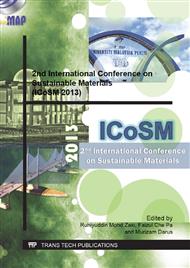p.692
p.697
p.701
p.707
p.711
p.716
p.721
p.726
p.732
Formation of Gold Nanoparticles Film on Silicon Wafer by Self-Assembled Method
Abstract:
The gold nanoparticles film has been successfully formed on the silicon wafer by self-assembled method. The gold colliods were prepared by chemical reduction method where sodium citrate (act as the reducing, capping and stabilizing agent) were added into the boiling 50ml of 0.01% tetrachloroauria acid (HAuCl4) solution in reflux system. Different particle size of gold colloids (AuNPs_1 and AuNPs_2) were produced by altering the amount of sodium citrate. The as-prepared gold colloids were characterized by UV - Vis spectrometry, Malvern particle size analyzer, zeta potential and XRD. Self-assembled method of Au nanoparticles were first start with the cleaning of silicon wafers using standard RCA cleaning, and followed by the piranha treatment to producing an OH-terminated surface. Then, the wafers were functionalized with organosilane molecule by immersing the silicon wafer in 10mM of surfactant in methanolic solution to produce self-assemble monolayers (SAMs) on silicon wafer surface. These layers were used to immobilize the gold nanoparticles from as-prepared gold colloid and result of the gold nanoparticles film on silicon wafer. Effect of surfactant ((3-aminopropyl) trimethoxysilane (APTMS) and (3-mercaptopropyl) trimethoxysilane (MPTMS)), effect of particle size of gold colloid (AuNPs_1 and AuNPs_2) and the effect of deposition time (0.5, 1.0, 1.5 and 2 hours) to the surface morphology such as surface coverage, inter-particle distance were studied in this work. The surface morphology of gold nanoparticles films were characterized by FESEM and AFM.
Info:
Periodical:
Pages:
726-731
Citation:
Online since:
September 2013
Authors:
Keywords:
Price:
Сopyright:
© 2013 Trans Tech Publications Ltd. All Rights Reserved
Share:
Citation:


